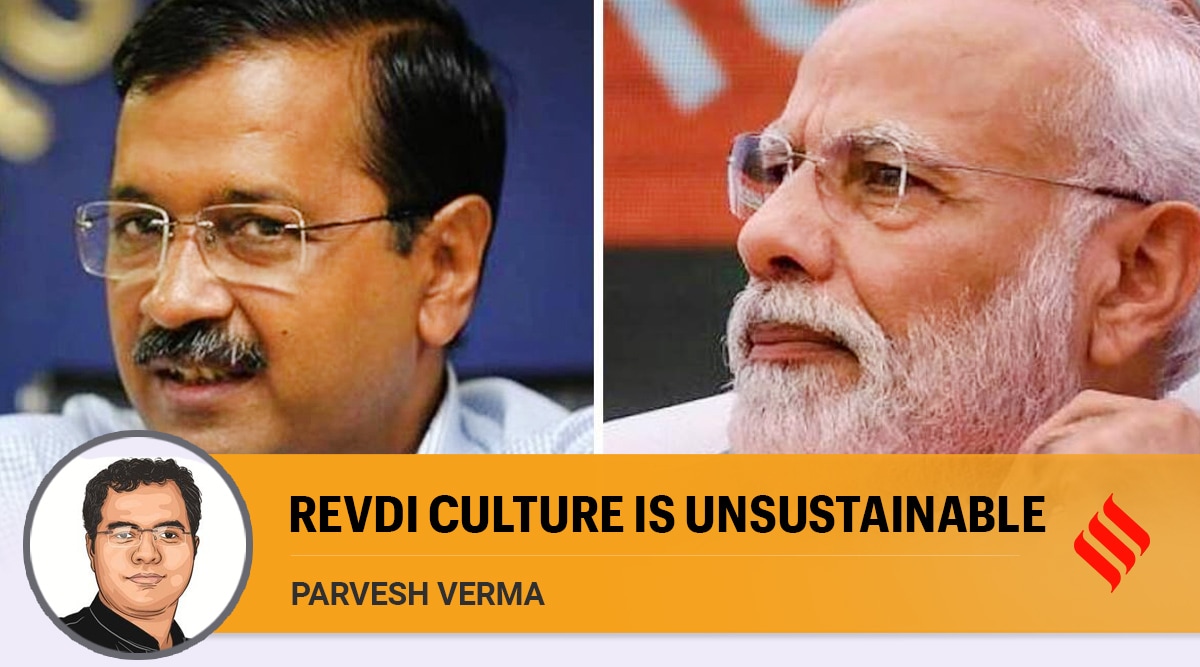 Arvind Kejriwal; Narendra Modi (File Photos)
Arvind Kejriwal; Narendra Modi (File Photos)Delhi Chief Minister Arvind Kejriwal seems to be perturbed by Prime Minister Narendra Modi’s appeal to the youth to choose governments that invest in long-term projects and programmes instead of relying on shortcuts such as freebies. Since entering electoral politics, the Delhi CM has been misrepresenting mere quid pro quo distribution of freebies as a comprehensive welfare model. His approach is in sharp contrast to the Modi government’s welfarism which bridges inequity in access to basic facilities and ensures no one is left behind.
Kejriwal’s much hyped “Delhi model” is an attempt to deceive the public through selective disclosures, misinformation, and exaggerated claims. How? The Delhi CM highlights free treatment in government hospitals and free education in government schools as a hallmark of his model. However, he deliberately omits the fact that state governments across the country have been providing free education and medical treatment for decades.
The Delhi government seems to have failed in expanding education and health infrastructure, the real barometer of success. In 2011-12, Delhi had 948 schools run by the Directorate of Education (DoE). In almost a decade, just 79 schools were started by the DoE and merely 18 of these were built under the Kejriwal government. In 2021-22, just two students received loans under the Delhi government’s loan scheme for higher education. However, the state government has spent 19 crore on advertising this scheme. An RTI revealed that no new government hospital was constructed by the Delhi government between 2015 and 2019. AAP’s highly publicised mohalla clinics have been missing in action during the city’s multiple Covid waves.
On the other hand, the Modi government has facilitated unprecedented expansion in higher education opportunities. Since 2014, two new colleges per day and one university per week have been established in India. The Centre has also launched the world’s largest government-funded healthcare programme, Ayushman Bharat, which has empowered more than 18 crore citizens to seek treatment at their hospital of choice.
Subscriber Only Stories
Which of these is an effective model for the country — a government that merely promises and fails to deliver or a government that is successfully transforming India’s health and education sectors while ensuring fiscal sustainability?
Contrary to Arvind Kejriwal’s claims, uninterrupted electricity and water supply remain distant dreams for a large proportion of Delhites as the government has chosen to transfer public resources to the affluent rather than those who need them the most. Subsidised electricity to all including the rich and upper-middle class cannot increase power supply for citizens. In fact, it can make matters worse through perverse incentives. Similarly, a universal water subsidy cannot relieve innumerable colonies and slums in the city from the tanker mafia.
This reckless distribution of freebies must be contrasted with the Modi government’s approach of providing targeted benefits. The Modi government provided 3.5 crore electricity connections across the country in less than two years. In about three years, the Modi government has relieved more than 6.75 crore households from the daily ordeal of collecting water.
The Delhi government’s claim of maintaining a revenue surplus despite extending various subsidies to citizens is another instance of selective disclosure to deceive the public. The surplus is not a new achievement. Delhi had a revenue surplus even during Sheila Dikshit’s tenure as chief minister. Moreover, various states including some big states ruled by the BJP such as Uttar Pradesh and Gujarat have a revenue surplus.
In fact, the revenue surplus in Delhi has declined under Kejriwal; almost 88 per cent as compared to 2010-11. In the current fiscal year, there is a high likelihood that the city may report a revenue deficit. There has also been a substantial increase in the city’s debt during his tenure — 39 per cent between 2012-13 and 2020-21.
Kejriwal repeatedly criticises the central government for creating hindrances for the state government. In reality, extensive central transfers and assistance are the bedrock of the “Delhi model”. Would Kejriwal have been able to provide freebies if central resources devolved to Delhi hadn’t increased by almost 10 times between 2015-16 and 2020-21? If he is so proficient in fiscal management, why did the Delhi government need to borrow more than Rs 4,700 crore from the Centre in 2019-20 alone? However, mounting fiscal pressure and accompanying challenges haven’t prevented Kejriwal from making a mammoth increase in advertisement expenditure. Ad spending increased by 44 times between 2012-13 and 2021-22.
A few days back, addressing the inauguration of the 2G ethanol plant in Panipat, PM Modi again reminded the public that shortcuts can lead to “short circuits”. The unravelling of Arvind Kejriwal’s “Delhi model” seems to be the perfect example. The ballooning burden of the electricity subsidy and weakening finances have forced Kejriwal to roll back the universal subsidy and make it optional. This decision was announced after Punjab had already signed up for free electricity and is carefully omitted from all announcements about electricity subsidy in Gujarat.
Similarly, due to rising expenditure on subsidies, the Delhi government has been unable to undertake much needed efforts to reinvigorate the city’s infrastructure. The government has failed to substantially increase its capital expenditure. Bus availability in the city has suffered due to a consistent reduction in fleet.
Kejriwal’s transactional welfarism must be contrasted with the central government’s focus on ensuring ease of living and holistic development by providing basic facilities such as banking, healthcare, electricity, water, housing, clean cooking fuel etc to crores of households across the country.
Instead of merely achieving piecemeal changes, policy makers should aim for paradigmatic transformation. This is the difference between the Modi government’s “transformation at scale” and the unambitious Delhi Model. This is the choice between a freebie-centric revdi culture and Modi’s welfarism.
The writer is a Member of Parliament